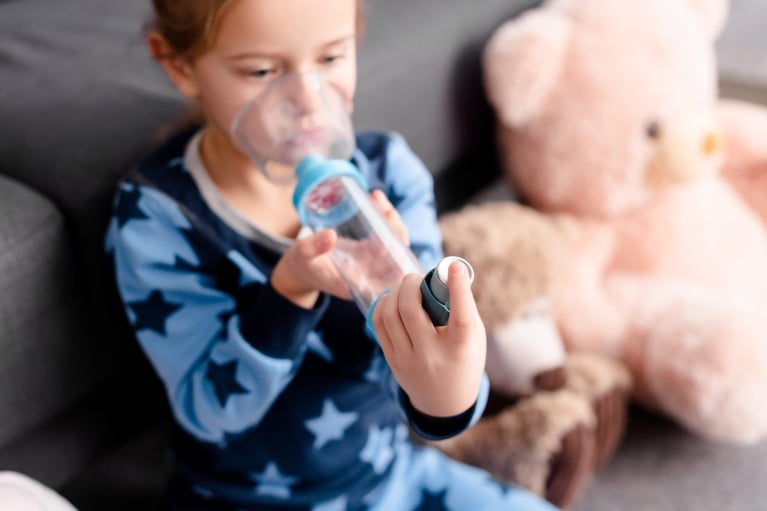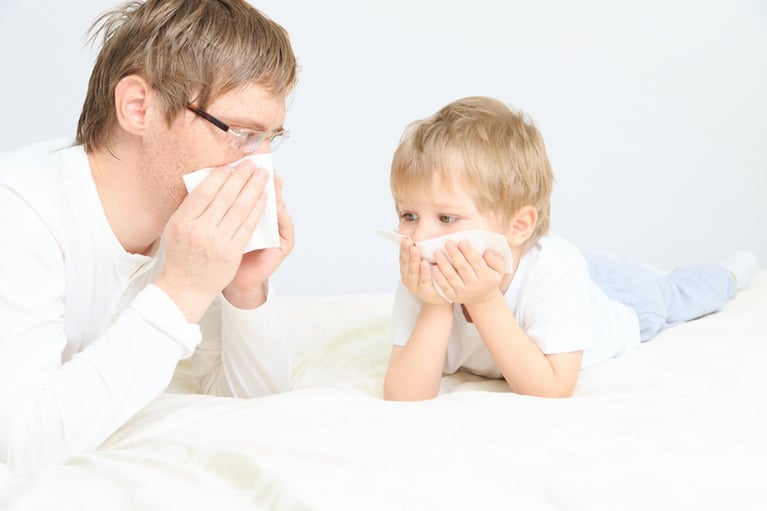Let’s start with a few questions…

- Do you have the impression that your doctor should know more about your child in order to be able to treat them efficiently?
- Do you have problems with booking a medical appointment? Are you overwhelmed by queues, waiting, stress and the cost of every single visit?
- Would you like to always have available the history of all the diseases that your child went through, together with the list of medicines applied, so that every doctor with whom you consult the health of your child has access to such information?
- Are you afraid of your child being exposed to another infection during a visit at the outpatient clinic or at the hospital?
- Do you think that a doctor should take into account all the health problems and predispositions and not only treat the problems that are becoming more severe at a given moment?
- Do you often consult Doc Google to check whether the reaction of your child to ongoing treatment is normal?
- If you’re a parent of an allergic child, would you like for your child to be under closer supervision during prolonged application of medicines, particularly steroids?

If you answered YES to at least some of those questions, you can be sure that the model of treatment and health inspection by means of application of telehealth solutions is appropriate for your family!
Let’s get to the point. The attitude of many people, towards the issue of telehealth has been quite sceptical until very recently. When most people hear the notion of telehealth, what comes to their mind is the image of a doctor wearing a headset, providing us with medical advice in a pattern-based, almost automatic manner. They couldn’t be more wrong! Modern telehealth does not attempt at competing with direct contact with a doctor and it’s not supposed to replace routine specialist consultation or examinations! Its purpose is to provide a supplementary and convenient option for patients and physicians that can help them control the treatment process and improve diagnostics, where possible. Ok, but one thing at a time…
Telehealth assumes the existence of the electronic medical report that can be accessed at any time by the doctor and the patient as well. It will be stored in our phone, PC or tablet. The report will include results of laboratory examinations, such as, for example, ECG and auscultation, comments to these examinations by specialist physicians, list of medicines and medical recommendations and the whole history of treatment, including e.g. surgical treatment, pharmacological treatment, etc. Thanks to a special application we’ll gain access to all that data and we’ll be able to review them and provide them to our doctor at any moment.
Let’s imagine a situation where our child suffers from asthma. Thanks to telehealth we always have handy the information on examinations that our child went through, medicines that they take, possible adverse effects that resulted from taking them and records from specialist consultations. Even when we go on holidays to the most distant corners of the world, the health condition of our child will remain under supervision and in case of any doubts we will be able to receive counsel via a telehealth platform.
And if during the trip we are forced to go to hospital for help, we will carry the whole medical records with us. From the point of view of a medical practitioner this seems to be a terrific solution! In emergency situations, when a patient is taken to the Hospital’s Emergency Department and examined by the physician on duty who meets such patient for the first time, such database is invaluable.


What comes next? Thanks to telehealth the attending physician is going to be able to supervise the treatment implemented. Meanwhile, the patient will be able to consult the efficiency of the medicines prescribed and their dosage and inform about any adverse effects. Thank to this, the efficiency of outpatient treatment will approximate that of hospital treatment. We will obtain quickly the recommendations whether to discontinue a given medicine, change its dosage or continue treatment with pharmaceutics. This enables reducing the number of unnecessary visits at the outpatient clinic. In case when our child suffers from vomiting, rash or persistent cough after administration of antibiotics, we will be able to contact our paediatrician and consult further procedure without having to take our child to the health care facility. This will spare both the child and us the unnecessary stress and contact with other sick children. And a bit of time as well.
Such a quick and direct contact with specialists is very important for patients suffering from chronic diseases and diseases of affluence – hypertension, diabetes or asthma. Choosing the right medicines for hypertension, appropriate insulin dosage or the right bronchodilators or steroids often requires several consultations with a specialist and they often receive feedback in rather long intervals. By applying the telehealth solutions combined with household measurement equipment the patient remains under constant supervision, as if they were staying in a hospital, and the treatment is optimized and adjusted whenever necessary.
Additionally, we often aren’t certain whether the current moment is the right one to consult a physician or not. Thanks to telehealth we will be able to resolve these doubts. The paediatrician with whom we consult the condition of our child is going to provide us with preliminary advice and suggest whether our child’s health requires immediate evaluation or it is necessary to wait a bit longer and observe. If necessary, they will order examinations or tests, such as laboratory blood and urine tests, and see us after we will have obtained the results.
Telehealth in Poland
All of this sounds very nice and promising, but is it real?
Telehealth is currently developing in the whole world and it experiences the fastest growth in the USA. Already in 2011, 50% of American patients took advantage of this form of contact with a physician.
Actually, the technical capabilities are already there and I believe that also in Poland people will realize that it’s a system that, when used properly, may help not only the patients but physicians as well.
At present in Poland we can take advantage of telehealth services offered by the Lux Med group, Telemedico platform and the largest certified telehealth platform – Medivio.

What is each of these companies offering? Let’s start with the LuxMed group, which enables its patients to contact a physician, nurse or midwife remotely using video, audio and classic text chat. At the Lux Med’s Patient’s Website (Portal Pacjenta) in the “Chat” tab there are published fixed schedules of medical specialists together with hours during which a virtual consultation can take place. The specialist can access the medical documentation and order specific tests and examinations, and the conversations and recommendations are recorded and become a part of medical documentation. It is an additional form of consultations, complementing the traditional consultation with a specific specialist.
The Telemedico platform enables quick consultation with a physician or another specialist (psychologist, dietician). A single consultation costs 39 PLN (connection with the currently available medical consultant, requiring a couple of minutes of waiting) or 59 PLN (if you want to select a specific specialist on a convenient date). It is also possible to buy a monthly, quarterly or annual subscription. The fact that we can talk almost immediately with a physician instead of looking for solution and diagnosis at Doc Google’s is a very good thing for many people. However, in this form this is rather a service that allows us to have an emergency consultation with a doctor, resolve doubts regarding symptoms appearing, obtain an additional opinion or ask for interpreting results of an examination or test. It is so because in this case the contact between the physician and the patient is limited to consultation in the virtual space.

It is different in case of Medivio telehealthplatform, the only certified telehealth platform in Poland. Here the contact between the physician and the patient is not replaced with a smartphone screen but rather expanded and complemented by telehealth solutions that ensure permanent contact with the physician. It is the physician who, during a traditional visit, subscribes their patients to the telehealth platform. From that moment on, all the examinations, tests and consultations are recorded on the patient’s electronic record which can be accessed by the patient, the physician and, if we grant consent to that, other physicians who treat us.
At home, the patient can use diagnostic devices monitoring their health condition. Thanks to that the physician obtains a complete information on the patient’s health condition and can adjust their treatment in real time. In case of chronic diseases the patient remains in home conditions but the care they receive corresponds to that of hospital care.
The animated video created by Medivio informs on the advantages of this solutions in an approachable manner.
It’s definitely the best and the most comprehensive solution, developing telehealth in the direction of holistic medicine and let me emphasize this again – it doesn’t limit the contact with the physician but expands it wisely.
Additionally, there are many devices being developed at present that, when combined with an appropriate telehealth platform, e.g. Medivio, may support the treatment and diagnosis provided to us, our children and our future grandchildren. Among them we can distinguish some already popular and “domesticated” devices such as: blood pressure meter, blood glucose meters and smart thermometers. Nowadays it doesn’t surprise anyone that such devices are present in households, although the older generations still remember that people used to have to go to a physician or biochemical laboratory in order to have their blood pressure or blood glucose checked. Now these standard devices are joined but further innovative ones that enable supervising out health condition. In Poland there has been created the Pregnabit device for pregnant women, which enables hearing the heartbeat of the foetus or, in other words, carrying out cardiotocography in household conditions. Soon there’s also going to appear a new electronic household stethoscope from the StethoMe® company, which will make it possible to send easily the recording of auscultation sounds to the physician, thus making it possible to have the respiratory system condition checked without even leaving home.

There is no doubt that in the future the telehealth solutions are going to provide a greater and better contact between patients and physicians, enable adopting a holistic approach to therapy of many diseases, particularly chronic ones (asthma, diabetes, hypertension) and, most likely, minimize the problem of queues to specialist outpatient units.
Nevertheless, it is obvious that similarly to all the things that are new, this also requires times and trust on part of both patients and physicians. If both sides experience improvement in treatment quality, the development of this field of medicine is going to be very quick.















